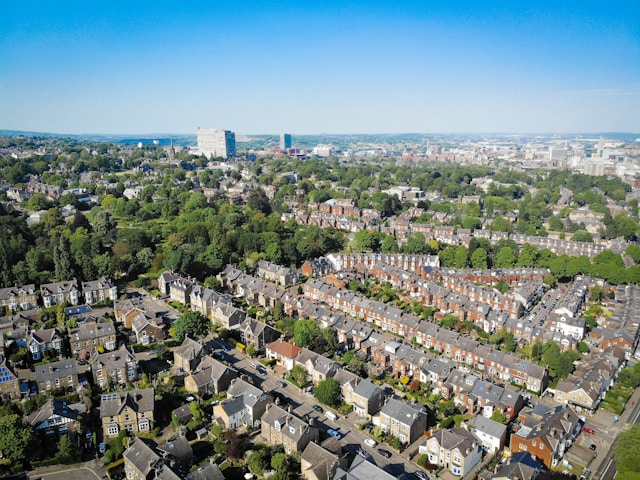When the mercury rises to 40 degrees Celsius, the UK has a unique set of challenges that make heatwaves feel particularly severe when the outside temperature reaches 40 degrees Celsius. The UK’s higher humidity levels, home insulation methods, and urban heat island effect combine to create a perfect storm of discomfort and health dangers, unlike other nations that often have equivalent temperatures. This article examines the reasons for the rising severity of heat waves in the UK and offers ways to lessen the impact they have.
A key factor in how heat is felt and endured is humidity. High humidity frequently coincides with heatwaves in the UK, exacerbating the feeling of heat. Sweating is the body’s method of self-cooling, but humidity hampers this process. Sweat evaporates more slowly in humid air, which makes it more difficult for the body to keep a suitable temperature. Heat exhaustion and heatstroke, in addition to heat stress, can occur from this.
Because the body can cool itself more effectively in dry regions, people there often find it easier to tolerate the heat, even in countries that have higher temperatures. On the other hand, the UK’s high humidity and temperatures make the heat feel much more dangerous and oppressive.
The typically colder climate in the UK means that homes are built to retain heat. This insulation can be helpful in the long, cold months, but in a heat wave, it becomes problematic. Homes with double-glazed windows, thick walls, and loft insulation retain heat inside during the summer while keeping it in during the winter.
This phenomenon is particularly pronounced in older homes with solid walls and limited ventilation. Modern buildings, while better insulated, can also become heat traps due to the extensive use of glass and materials that absorb and retain heat. The lack of air conditioning in many UK homes further compounds the problem, leaving residents with few options to cool down their living spaces.
Urban areas are significantly warmer than their rural counterparts due to the urban heat island (UHI) effect. This occurs because buildings, roads, and other infrastructure absorb and re-emit the sun’s heat more than natural landscapes. Cities like London can be several degrees warmer than surrounding areas, intensifying the impact of a heatwave.
The UHI effect is exacerbated by factors such as air pollution and reduced airflow between buildings. During a heatwave, the cumulative effect of heat-retaining materials, high-density living, and limited green spaces can create dangerously hot environments. Nighttime temperatures also remain high in urban areas, providing little respite from the daytime heat.
Addressing the challenges posed by heatwaves in the UK requires a multifaceted approach:
- Improving Building Design: Future buildings should be designed with climate resilience in mind. This includes incorporating features such as reflective roofing materials, external shading devices, and natural ventilation systems. Retrofitting existing buildings with better ventilation and heat-reflective materials can also help.
- Expanding Green Spaces: Increasing the number of parks, green roofs, and tree-lined streets can mitigate the UHI effect. Green spaces not only provide shade but also help to cool the air through the process of evapotranspiration. Urban planning should prioritize green infrastructure to create cooler, more livable cities.
- Promoting Air Conditioning: While widespread use of air conditioning can increase energy consumption, it is a necessary adaptation in the face of more frequent and intense heat waves. Encouraging the use of energy-efficient air conditioning units and integrating them into public buildings and transport systems can provide relief during extreme heat.
- Raising Awareness: Public education campaigns can help people understand the risks associated with heat waves and how to protect themselves. This includes advice on staying hydrated, avoiding strenuous activities during peak heat, and recognizing the signs of heat-related illnesses.
- Enhancing Emergency Preparedness: Local authorities should have heatwave response plans in place, including provisions for vulnerable populations such as the elderly and those with pre-existing health conditions. Cooling centres, heat alerts, and emergency services should be part of a coordinated response to extreme heat events.
Heatwaves in the UK present unique challenges due to high humidity, heat-retaining buildings, and the urban heat island effect. These factors combine to make high temperatures more unbearable and hazardous compared to other regions. By improving building designs, expanding green spaces, promoting the use of air conditioning, raising public awareness, and enhancing emergency preparedness, the UK can better cope with the increasing frequency and intensity of heat waves. As climate change continues to raise global temperatures, these measures will be essential in protecting public health and ensuring comfort during the hottest days.
By addressing these factors, the UK can make strides in adapting to the hotter summers predicted by climate change, ensuring that residents can stay safe and comfortable even during extreme weather events.
